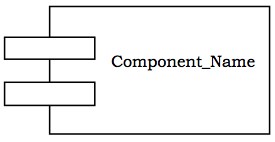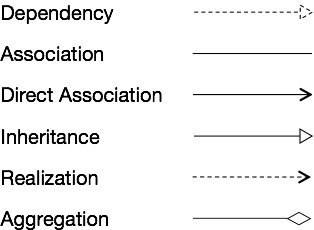A Class and Its Members Can Be Described Graphically Using a Notation Known as the ____ Notation.
OOAD - UML Basic Notations
UML defines specific notations for each of the edifice blocks.
Class
A course is represented by a rectangle having three sections −
- the top section containing the name of the class
- the middle section containing grade attributes
- the bottom section representing operations of the class
The visibility of the attributes and operations can exist represented in the post-obit ways −
-
Public − A public fellow member is visible from anywhere in the system. In class diagram, it is prefixed by the symbol '+'.
-
Individual − A individual member is visible only from within the form. It cannot exist accessed from exterior the class. A private member is prefixed by the symbol '−'.
-
Protected − A protected member is visible from within the class and from the subclasses inherited from this course, simply not from outside. It is prefixed by the symbol '#'.
An abstract class has the class proper name written in italics.
Example − Let us consider the Circle form introduced earlier. The attributes of Circumvolve are x-coord, y-coord, and radius. The operations are findArea(), findCircumference(), and scale(). Let us assume that x-coord and y-coord are private data members, radius is a protected data member, and the member functions are public. The following figure gives the diagrammatic representation of the class.

Object
An object is represented as a rectangle with two sections −
-
The top section contains the name of the object with the name of the class or package of which it is an instance of. The name takes the following forms −
-
object-name − grade-name
-
object-proper name − class-name :: bundle-proper name
-
class-name − in example of anonymous objects
-
-
The bottom department represents the values of the attributes. It takes the form attribute-name = value.
-
Sometimes objects are represented using rounded rectangles.
Example − Let us consider an object of the form Circle named c1. We assume that the middle of c1 is at (ii, 3) and the radius of c1 is v. The following figure depicts the object.

Component
A component is a concrete and replaceable function of the organisation that conforms to and provides the realization of a set of interfaces. It represents the concrete packaging of elements similar classes and interfaces.
Annotation − In UML diagrams, a component is represented by a rectangle with tabs as shown in the effigy beneath.

Interface
Interface is a collection of methods of a class or component. It specifies the prepare of services that may exist provided by the class or component.
Annotation − Generally, an interface is drawn as a circle together with its name. An interface is almost always fastened to the course or component that realizes it. The following figure gives the notation of an interface.

Package
A package is an organized group of elements. A package may contain structural things similar classes, components, and other packages in information technology.
Notation − Graphically, a package is represented by a tabbed binder. A package is generally drawn with only its name. Still it may take boosted details most the contents of the package. See the following figures.

Human relationship
The notations for the dissimilar types of relationships are as follows −

Unremarkably, elements in a relationship play specific roles in the human relationship. A role name signifies the beliefs of an chemical element participating in a certain context.
Example − The following figures show examples of different relationships between classes. The showtime figure shows an association betwixt 2 classes, Section and Employee, wherein a department may take a number of employees working in it. Worker is the part proper name. The '1' alongside Department and '*' aslope Employee depict that the cardinality ratio is one–to–many. The second figure portrays the assemblage relationship, a University is the "whole–of" many Departments.

Useful Video Courses

Video

Video

Video

Video

Video

Video
Source: https://www.tutorialspoint.com/object_oriented_analysis_design/ooad_uml_basic_notation.htm
0 Response to "A Class and Its Members Can Be Described Graphically Using a Notation Known as the ____ Notation."
Post a Comment